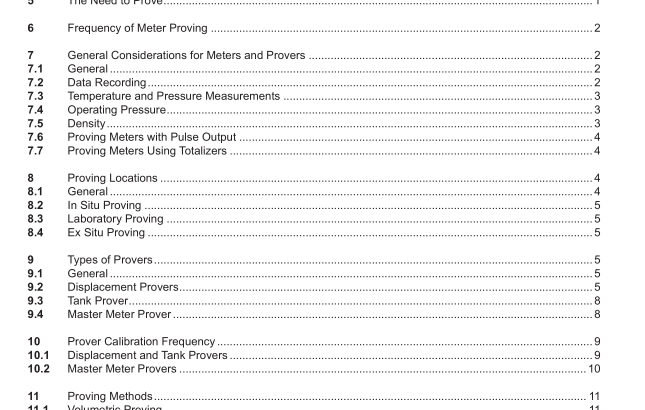API MPMS 4.8:2021 pdf free download.Manual of Petroleum Measurement Standards Chapter 4.8 Operation of Proving Systems
6 Frequency of Meter Proving The frequency required for proving varies from several times a day to twice a year or even longer depending upon the reasons listed in Section 5. Other reasons are:
a) value of the liquid,
b) cost/beneft to prove,
c) meter proving history,
d) meter system stability,
e) variations of operating systems.
The actual proving frequency is dependent upon the contract or procedures established by the operator of the metering system. This standard does not defne proving frequency of meters. In general, the proving frequency for a new system starts with short intervals and may be extended to longer intervals as confdence increases in the system.
The operator should specify the interval of time or a quantity of throughput, after which the meter should be proved again. In a situation where custody transfer accuracy is not required, and where viscosity and temperature do not vary too widely, it may be sufcient for meters to be re-proved at specifed intervals, such as every month or two when the metering system is new, extending to once in six or perhaps 12 months when the reliability of the meter system has been established.
7 General Considerations for Meters and Provers
7.1 General The meter should be operated within its performance curve, and the prover should be operated within its fow rate limitations. The meter should be proved as close as practical to the same conditions under which it normally operates. Meter performance is dependent upon process conditions. Therefore, during proving it is essential that fow rate be maintained within the normal operating fow range of the meter.
7.2 Data Recording Manually recording data during the prove limits the ability to track changes in operating conditions over the proving and may increase the uncertainty of the meter factor. For manual data recording, it is necessary to prove under the following conditions to minimize meter factor uncertainty:
a) stable fuid composition,
b) stable fuid temperature and pressure,
c) stable fuid fow rate.
The use of automated data recording and computational software (proving computer) reduces the uncertainty of the meter factor by averaging the changes in operating conditions and taking a greater number of data points over the proving. The amount of variation that can be tolerated before afecting the repeatability requirement or uncertainty, or both, varies by liquid hydrocarbon type and actual operating conditions.
7.3 Temperature and Pressure Measurements
7.3.1 General Accurate temperature and pressure measurements are necessary for all types of proving, except direct mass proving. Proving systems with automated (computerized) recording of the required meter and prover data reduces proving uncertainty as compared with manual measurements.
These two operating conditions should be stabilized (in equilibrium) for best proving results. Stability of these conditions during the proving reduces meter factor uncertainty.
7.3.2 Location Prover temperature and pressure measurement shall be taken at locations as described in API MPMS Ch. 4.2, API MPMS Ch. 4.4, and API MPMS Ch. 4.5 as applicable. Meter temperature and pressure measurement shall be taken at locations as described in API MPMS Ch. 5.1 as applicable.
7.3.3 Accuracy
Temperature and pressure values shall be within the ranges of the appropriate volume correction equations/ tables (API, GPA). Thermometers or temperature transducers used for proving shall be the highest practical resolution as recommended in API MPMS Ch. 7 [10] .
Pressure gauges or pressure transducers shall be selected with a resolution that enables the recording of pressure values as required in API MPMS Ch. 12.2.
7.3.4 Discrimination
The proving temperature and pressure values shall be recorded as required in API MPMS Ch. 12.2.
7.4 Operating Pressure It is essential that both the prover and meter pressures be higher than the equilibrium vapor pressure of the liquid during proving. In lieu of an actual test, or test data to determine back pressure requirements, the minimum back pressure should be 2 times the pressure drop through the fow meter plus 1.25 times the equilibrium vapor pressure (reference API MPMS Chapter 5—Metering [3] —various sections for minimum back pressure requirements).API MPMS 4.8 pdf download.API MPMS 4.8:2021 pdf free download
